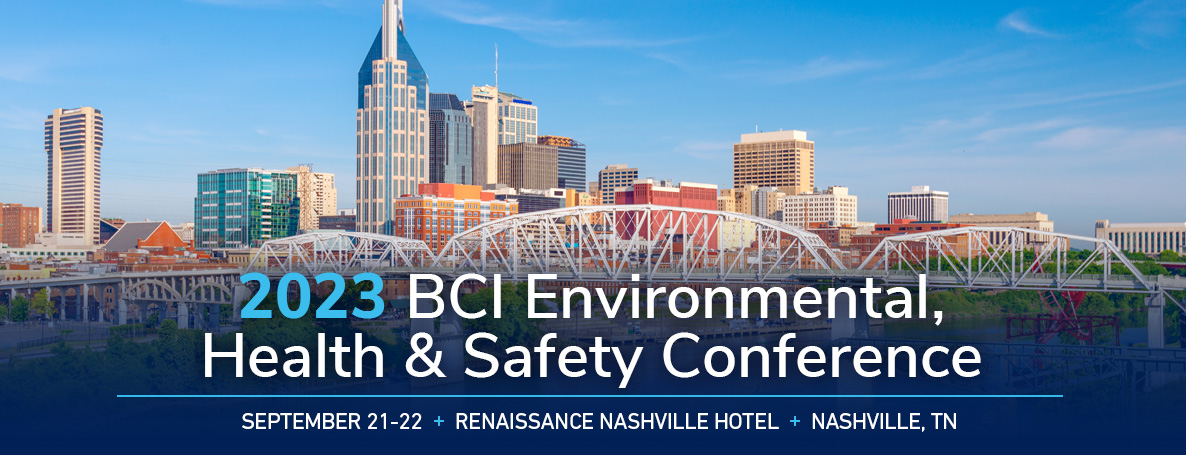2023 BCI Environmental Health & Safety Conference

The bi-annual BCI EHS Conference is the largest meeting of lead battery manufacturing and recycling industry EHS professionals in the nation. Attendees gain extensive opportunities for learning and networking for EHS and safety professionals, with a two day agenda full of comprehensive educational presentations, panel discussions and peer-to-peer sharing.
Conference Agenda
7:00 – 9:00am
Registration
Coffee and Networking
9:00 – 9:10am
Introduction and Welcome
Roger Miksad – Battery Council International
Session 1
9:10 – 9:45am
North American and Int’l Regulatory Overview
Roger Miksad – Battery Council International
A legislative and regulatory update from BCI’s President and Executive Director.
Session 2
9:45 – 10:30am
EPA and OSHA Enforcement Trends
Carol McCabe – Manko Gold
Jill Kaplan – Manko Gold
The session will cover a discussion of EPA and OSHA enforcement trends potentially affecting BCI member companies and their operating facilities. Likely topics will include enforcement priorities, Environmental Justice drivers, agency inspections and information requests, settlement mechanisms and penalty assessments.
10:30 – 10:45am
Break
Session 3
10:45 – 11:20am
Best Practices for Handling an EHS Compliance Inspection
Mike Liebert – ALL4
The session will cover a discussion of how to handle audit questions; responding to document requests; the fundamentals of attorney/client privilege; and how to negotiate if you receive a Notice of Violation (NOV).
Session 4
11:20am – 12:00pm
Member Experiences with Inspections
Panel Discussion
Moderator: Manko Gold
Panelist 1: Eric Rueter – U.S. Battery
Panelist 2: Eric Peffel – East Penn Manufacturing
12:00pm
Lunch
Session 5
1:00 – 2:00pm
Medical staff – Non-lead Issues
Panel Discussion
Moderator and Panelist: Laurie Heagy – East Penn Manufacturing
Panelist 2: Lisa Greenly – EnerSys
Panelist 3: Angela Natole – BSN, COHN-S Crown Battery
Topics may include:
- Workers Comp, Disability, ADA
- “Day to Day of Manufacturing Facility Nursing Staff”
- RTW (non-lead injury/illness/accommodations/other)
- Update on Drug Testing (from 2021 conference)
Session 6
2:00 – 3:00pm
Assigned Protection Factors and How Changes to Occupational Exposure Limits (OELs) Can Impact Respirator Selection
Scott Shinn – 3M
The selection of adequate respiratory protection for workers includes many elements, one of which is using published Assigned Protection Factors to select the appropriate class of respirator to help reduce airborne exposure below the Occupational Exposure Limits (OELs). Several national and local agencies, including the State of California and the European Commission have proposed a reduction to the current lead OEL. This session will provide a general overview of the respirator selection process and illustrate how the lowering of the lead OELs may affect respirator selection.
3:00 – 3:15pm
Break
Session 7
3:15 – 4:15pm
Guest Speakers from The National Institute for Occupational Safety and Health
- NIOSH and the Adult Blood Lead Epidemiology and Surveillance (ABLES) program – Rebecca Tsai, NIOSH
- The Occupational Safety and Health (OSH) Act was enacted in 1970 to promote safe and healthy working conditions for all workers, regardless of their age, sex, race/ethnicity, or salary. As part of the OSH Act, the National Institute for Occupational Safety and Health (NIOSH) was created as an independent research program that generates objective scientific research findings in the field of occupational safety and health. Among NIOSH’s many programs and initiatives is the Adult Blood Lead Epidemiology and Surveillance (ABLES) Program. ABLES is a state-based program that was created in 1991 to reduce elevated Blood Lead Levels (BLLs) among working adults 16 years and older. The ABLES program examines industries and occupations where exposures are occurring across the United States and uses this information to guide interventions and prevent work-related lead exposures.
- Dissolution of inorganic lead compounds in synthetic sweat to assess risk of dermal exposure – Todd Niemeier, NIOSH
- It is estimated that over 4.53×108 kg of inorganic lead (iPb) compounds were manufactured in the U.S. in 2020. Over 1.4 million U.S. workers have dermal exposures to iPb compounds in several industries with loading of iPb on hands varying widely (0.005-16.1 µg/cm2 ). In vitro skin studies suggest that dermal exposures to iPb could increase blood lead levels (BLLs) by as much as 6.3 µg/dl. However, these studies did not evaluate the dissolution of iPb compounds in skin surface film liquids (SSFLs) (including both synthetic sweat and sebum) to determine the potential for Pb ion formation. This study’s objectives were to 1) determine the pH-dependent static dissolution of four iPb compounds in SSFLs: Pb2+ nitrate (PbN), Pb2+ acetate (PbA), Pb2+ oxide (PbO), Pb2+/4+ red oxide (PbRO); 2) evaluate iPb dissolution kinetics; and 3) provide screening estimates of the potential impact of these compounds on BLLs (assuming exposure to hands only). Statistical analysis using SAS® to fit negative exponential functions to data and calculate dissolution parameters were completed. Using the output from these data analyses, along with dermal loading estimates of Pb compounds in workplace settings, provides a starting estimate for the concentration of Pb ions potentially available in the sweat layer on skin. Estimated concentration of Pb ions available on the skin was used along with available Kp estimates to provide more robust understanding of the potential for dermal bioavailability of these compounds. These iPb compounds are bioaccessible in SSFLs; PbN and PbA have higher dissolution at 8 h (36.4–61.1%) compared to PbO and PbRO (0.01–2.5%). pH has a statistically significant effect on bioaccessibility for all four compounds tested. Screening estimates suggest that BLLs may be increased by 0.7-8 µg/dL for these iPb compounds. To our knowledge, this is the first report of iPb dissolution rates in SSFLs to inform bioaccessibility estimates of iPb for dermal risk assessment. The screening level estimates based on this model suggest that the impact on BLLs warrants a more comprehensive assessment. In work settings where other routes of exposure to iPb may be relevant, dermal exposure estimates may represent a significant relative source contribution to overall body burden of Pb exposure. Examination of the impact of dermal exposures on BLLs could be incorporated into physiologically-based pharmacokinetic models to provide a more robust understanding on the impact on BLLs. Given the potential for Pb ion availability to enable dermal absorption of Pb as demonstrated in this study and previously in the literature, reducing Pb exposure on skin may be important for reducing overall worker exposure to iPb.
- Evaluating residential lead removal from clothing – Chandran Achutan, NIOSH
- Take-home lead—where lead deposited on the clothes of workers is carried over to their personal environments—is a significant public health issue. It can contaminate personal vehicles and homes and harm children and other adults in the household. In workplaces where there are no showering or laundry facilities, workers launder contaminated clothes at home. But there is little data on how much lead is removed from residential laundry. In this presentation we will discuss an experimental study where known amounts of lead nitrate were spiked on three types of fabrics and laundered using a common consumer laundry detergent. Three levels of lead nitrate—9 µg (micrograms), 900 µg, and 9000 µg were spiked on 3 cm x 3 cm fabric swatches. The swatches were washed in a Whirlpool laundry machine. We found that lead adhered most to Blue Jeans Material (percent removal was 66.6%). Lead removal from T-shirt Material (95.1%) and Dickie’s Pant Fabric (97.4%) was high. This pilot study is limited in its ability to draw conclusions. More studies need to be done with different forms of lead, washing techniques, and detergents.
Session 8
4:15 – 5:00pm
BCI Worker Blood Lead Improvement Programs
Panel Discussion from EHS Leads for Battery Manufacturers and Recyclers
Moderator: Roger Miksad – BCI (Presentation of BCI BLL Program and Results)
Panelist 1: Renee Geiger – East Penn Manufacturing
Panelist 2: Jim Anderson – Crown Battery
Panelist 3: Adam Holbrook – EnerSys
5:00 – 6:30pm
Group Cocktail Reception with Hors D’oeuvres
7:45 – 8:30am
Group Breakfast
Session 1
8:30 – 9:15am
Update on Blood Lead Health Science (SPHRL and ILA/BCI PbPk Analyses)
Dr. Cris Williams – International Lead Association
The principal goal of ILA’s health science program is to conduct studies that serve to fill information gaps in the health science literature for lead and to address precautionary approaches to regulating lead that tend to arise in the absence of information. The ILA health science program is a shared (ILA/BCI/ABR) resource that addresses the regulatory challenges facing the lead industry in Europe and elsewhere overseas, as well as in North America and in the US. Several recently completed and ongoing projects within the health science program are focused on current US regulatory challenges to industry presented by the ongoing reviews of EPA’s lead National Ambient Air Quality Standard and OSHA’s occupational lead standard. The status of three principal health science projects that were specifically designed to address key scientific aspects of the lead NAAQS and the OSHA lead standard will be presented – these are the Worker Health Study, or SPHERL; the Air Pb:Blood Pb Study; and the Cardiovascular Disease Mortality Study.
Session 2
9:15 – 9:45am
Intelligent Monitoring and Control of Environmental Equipment Systems
Vahid Mirsaiidi – Auburn FilterSense
This presentation will discuss advancements in monitoring and control of facility ventilation and pollution control systems. Connecting data inputs using existing control infrastructure or third-party solutions to improve system performance and compliance.
9:45 – 10:00am
Break
Session 3
10:00 – 10:30am
Employee Training Programs – Best Practices and Programs
- Onboarding of new employees & supervisors (lead and other safety, e.g., forklift, injury, LOTO)
- Training – recurring supervision, in-house mentors?
- Safety supervision skills training / needs
Moderator: Jeramy LeMieux – Clarios
Panelist 1: Renee Geiger – East Penn Manufacturing
Panelist 2: Adam Bressler – EnerSys
Panelist 3: Jyl Zeis – Crown Battery
Session 4
10:30am – 11:00am
Update on EU Regulatory Changes – Battery Regulation and Green Deal
Rene Schroeder – EUROBAT
Session 5
11:00am – 12:00pm
60 Ideas in 60 minutes
Roger Miksad – Battery Council International
Every attendee gets 60 seconds to share an idea, or newly learned strategy, for reducing worker exposure to lead.
12:00 – 12:10pm
Closing Remarks
Separate session track intended for EHS professionals and companies new to lead regulation.
Session 1
8:30 – 9:15am
Lead EHS 101 – An introduction to lead EHS issues for non-EHS professionals and new EHS staff.
Russell Kemp – Ramboll
Session 2
9:15 – 10:00am
OSHA Requirements for Facilities Handling Lead Today and Under Future Cal-OSHA
Victoria Sparks – All4
10:00 – 10:15am
Break
Session 3
10:15 – 11:00am
Ventilation Design, Implementation, and Practical Considerations
Russell Kemp – Ramboll
Session 4
11:00am – 12:00pm
The Principle Elements of a Blood Lead Minimization Program Including the Fundamentals of Work Personal Hygiene and Take Hom Lead Prevention
Dan Askin – ESCA Tech, Inc.
12:00 – 1:00pm
Lunch
Session 5
1:00 – 1:45pm
Putting it All Together
Roger Miksad – Battery Council International
Susan Bernard – Battery Council International
BCI strives to create a safe, productive, and welcoming environment for all of our events. Please read our Events Code of Conduct policy.



